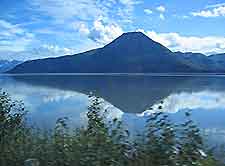Anchorage History Facts and Timeline
(Anchorage, Alaska - AK, USA)

Located on land formerly belonging to
Russia, Anchorage is the largest city in Alaska and one of the youngest cities in the
USA.
Despite its relatively youthful age, Anchorage has an interesting history, dating back to its initial discovery by James Cook, the famous British explorer and navigator, in 1778. He beat the Russian explorers who had set up bases in southern Alaska four years earlier, yet it was the Russians who exerted the earliest cultural and economic influence on the region. In 1867, Russian America was sold to the USA for US$7.2 million and the modern history of Anchorage began in earnest.
US Railways
The first settlements in the area now occupied by Anchorage sprang up in 1915. A tent city which housed construction workers who were building the Alaska Railroad quickly grew to accommodate 2,000 people. The settlement had no fixed name at this time, but the US post office here used the name 'Anchorage', which stuck.
The railroad was completed in 1923, although the development of a more permanent settlement to the south of 'Tent City' meant that Anchorage was actually incorporated as a city in 1920. The Anchorage Museum of History and Art houses exhibits on Alaskan history, giving a glimpse into the city's earliest days.
Early Growth
The arrival of the railway in 1923 ensured that the city continued to flourish, and throughout the 1920s and '30s the city expanded its distinctive grid system on which Anchorage streets are based. Although the city is now well-spread out, most tourists stay in its historic center, which today features restaurants, souvenir shops and a railway station.
The economy grew further after 1930, with the arrival of air connections and military activity. Merrill Field was the original airstrip prior to 1951, when the Anchorage International Airport opened. However, Merrill Field still serves the city to this day, providing an essential service to general aviation flights.
The Good Friday Earthquake
On 27th March 1964, the epicenter of the largest earthquake ever to hit North America was recorded just 80 miles / 129 km from Anchorage. Registering a massive 9.2 on the Richter scale, the five-minute long earthquake caused untold damage to city buildings and the death of 115 local residents. The remainder of the decade was largely spent rebuilding the city and fixing the estimated damages of US$311 million. In 1968, Anchorage continued its recovery from this dark day in history, with the Prudhoe Bay oil discovery.
Modern-Day Skiing and Tourism
North Slope oil money allowed local authorities to invest in Anchorage throughout the 1970s and '80s. The city's beautification program meant that it began to appeal to visiting tourists, many of whom enjoyed the nearby skiing trails which were developed.
The Hilltop Ski Area, established in 1984, is the oldest skiing area. It is located around 15 minutes' drive from the city center, while Anchorage is also a good base for visiting Alaska's biggest ski resort, Alyeska Resort in Girdwood.
 Located on land formerly belonging to Russia, Anchorage is the largest city in Alaska and one of the youngest cities in the USA.
Located on land formerly belonging to Russia, Anchorage is the largest city in Alaska and one of the youngest cities in the USA.